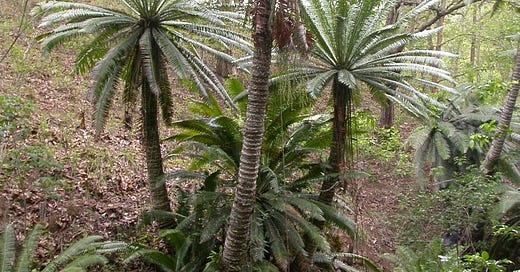I first came across teosinte back in 1999, while doing doctoral research in Honduras. Previously, I had thought the name referred exclusively to the ancestor of maize, but in the Jurassic cattle pastures of Saguay, Olancho, I found it attached to ancient, palm-like cycads.
Cycad Dreams
The mystery of how the native Honduran cycad Dioon mejiae ended up with the same common name as Zea mays parviglumis of Mexico, corn’s genetic ancestor, became first a sideline and then a consuming passion for me. Relegated to an obscure corner of my dissertation, the clash between Olancho’s tiusinteros (cycad-gatherers) and ganaderos (ranchers) caught the attention of Jody Haynes, a Florida-based cycad biologist, in 2002. He tapped me for a collecting expedition to Honduras the following year, which I was more than happy to help organize, as it included support for geographical field research and community-based conservation alongside the collection of cycads and palms.
After that, I was inducted into the esoteric global society of cycadophytes, a motley collection of highly credentialed botanists who mix uneasily with professional cycad collectors, all fiercely protective of the most endangered group of biota on the planet. Their obsessive fascination for these extraordinary plants borders on addiction; as a geographer and a “bird person,” I can’t say I understood much of the technical nature of their discussions at first, but I certainly understood their passion. My interest was (and remains) the human geography of cycads, AKA ethnobotany or economic botany. I wanted to know what local people knew about cycads and what they did with them. I was also committed to figuring out ways that cycads could be protected in the wild by these same people.
In some cases, cycad conservation isn’t harder than promoting renewed appreciation and protection of valued species like teosinte (now styled as tiusinte) which has long been harvested sustainably as food and for its leaves. Other cases are trickier—the related camotillo cycad (Zamia standleyi and others), for example, is greatly stigmatized and feared due to its use in a concoction one slips to one enemies, who, sooner or later, die an agonizing death.
For cycads, it is true, are among the most terrifying plants one can encounter. For all their beauty and their value for ornament and food, they remain among the most toxic group of living things. The poisons that have helped them survive the last 300 million years attack the central nervous system as well as the liver, and provoke everything from nausea and vomiting to loss of the use of hind limbs, and of course death.
Despite being so deadly—or perhaps because of it—cycads are deeply revered in many cultures. In places as distinct as the Ryukyu Islands of Japan, the Pacific nation of Vanuatu, the Xi’iuy town of Santa Maria Acapulco, San Luis Potosi and the Chiapaneco town of Jiquipilas, Chiapas, both in Mexico, and the towns of Gualaco and Esquipulas del Norte, Honduras, cycads are central to cultural identity and figure prominently in religious and secular celebrations. There, they are eaten, or drunk, or both, and they are openly displayed and talked about. In other places, they are denigrated, ignored, or forgotten in the rush to modernity. In still other locations they are under the purview of shamans and traditional healers, their very existence kept secret from outsiders.
The subject of this talk is the relationships between cycads and maize, and in particular the significance of a nearly-forgotten cycad/maize deity who goes by “Teosintle” and many other names. In this guise, he is often cast as a “maize hero,” a boy who first found maize, or changed into maize, and remains the eternal friend and companion of maize, helping it grow strong and fertile. Elsewhere, cycads are also shapeshifters, morphing into serpents, phoenixes, and a range of monsters, into people, and back into plants. Their deified aspects reflect qualities such as their deadliness, bountifulness, seeming birth and rebirth from fire, two genders, and extreme age.
One of the ways all this makes sense is that cycads are also peyote: they can provoke visions, much like the Mexican cactus that goes by the same name. Thus, this may also be a story about plant domestication with precepts far stranger than the typical explanations one hears so often, explanations on which no one really agrees. By now, we know that cycads had something to do with maize domestication—they are a cultural ancestor in the literal sense of the term. Though there was never any possibility of establishing a genetic cousinhood between cycads and grasses, a certain mystical hybridization happened nonetheless. It could just be that ancient cycads, as entheogens, were part of a conversation of visions that illuminated the path to the ear of corn. Think of it: the world’s deadliest plants, making copies of themselves, becoming the mainstay of the human diet.





Share this post